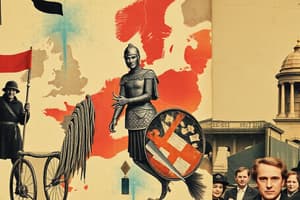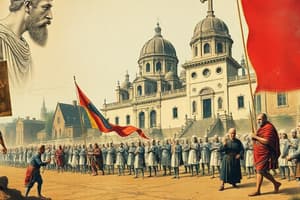Podcast
Questions and Answers
Which of the following best describes the social structure of the Germanic tribes?
Which of the following best describes the social structure of the Germanic tribes?
- A society divided into distinct classes including nobles, free men, and slaves, with a tribal council and chief leading them. (correct)
- A theocratic society ruled by priests, with religious law dictating social status and obligations.
- A rigid hierarchy based solely on land ownership, with no social mobility.
- An egalitarian society with no social classes, where all members participated equally in decision-making.
How did Germanic tribes primarily sustain themselves economically?
How did Germanic tribes primarily sustain themselves economically?
- Almost exclusively through piracy and raiding of coastal settlements.
- Through a combination of herding, agriculture, and craftwork, using resources like wood and clay where metal was scarce. (correct)
- Primarily as nomadic hunter-gatherers, moving frequently to follow game.
- Through large-scale manufacturing and international trade networks.
How did Julius Caesar contribute to the understanding of Germanic tribes?
How did Julius Caesar contribute to the understanding of Germanic tribes?
- His \*Commentaries\* (51 BC) provided early, though potentially biased, accounts of Germanic peoples and their territories. (correct)
- He wrote detailed ethnographic studies on their customs, religious beliefs, and social structure without personal bias.
- He established long-lasting peace treaties with the major Germanic tribes, leading to cultural exchange and mutual understanding.
- He adopted Germanic governance and integrated it into the Roman system.
Which factor most contributed to the limited availability of metal goods among the Germanic tribes?
Which factor most contributed to the limited availability of metal goods among the Germanic tribes?
Which of the following statements accurately reflects the political organization of the Germanic tribes?
Which of the following statements accurately reflects the political organization of the Germanic tribes?
Consider the geographical distribution of Germanic tribes. Which of the following river systems was most closely associated with the East Germanic peoples?
Consider the geographical distribution of Germanic tribes. Which of the following river systems was most closely associated with the East Germanic peoples?
What role did the 'Volksthing' play in the society of Germanic tribes?
What role did the 'Volksthing' play in the society of Germanic tribes?
What was the significance of runes to the ancient Germanic tribes?
What was the significance of runes to the ancient Germanic tribes?
What was the primary catalyst for the Visigoths' conflict with the Roman Empire in the late 4th century?
What was the primary catalyst for the Visigoths' conflict with the Roman Empire in the late 4th century?
Which factor significantly weakened the Roman Empire's borders, contributing to the Germanic incursions during the late 4th century AD?
Which factor significantly weakened the Roman Empire's borders, contributing to the Germanic incursions during the late 4th century AD?
The term Gaul refers to a region encompassing which of the following modern-day countries?
The term Gaul refers to a region encompassing which of the following modern-day countries?
Before 300 AD what was the conversion rate like of Germanic tribes converting to Christianity?
Before 300 AD what was the conversion rate like of Germanic tribes converting to Christianity?
The battle at Teutoburg Forest was significant for what reason?
The battle at Teutoburg Forest was significant for what reason?
What was the main consequence of the Great Migration with respect to the Roman Empire?
What was the main consequence of the Great Migration with respect to the Roman Empire?
What event occurred at the end of the 4th century AD that changed the Roman Empire?
What event occurred at the end of the 4th century AD that changed the Roman Empire?
What military strategy did Germanic tribes Commonly employ against roman forces?
What military strategy did Germanic tribes Commonly employ against roman forces?
What strategic imperative drove the Roman Empire to fortify the Rhine and Main rivers following their conquest of Gaul?
What strategic imperative drove the Roman Empire to fortify the Rhine and Main rivers following their conquest of Gaul?
What was the primary catalyst for the Germanic rebellion against Roman rule in 9 AD, led by Arminius?
What was the primary catalyst for the Germanic rebellion against Roman rule in 9 AD, led by Arminius?
How did the Germanic tribes effectively defeat the Roman legions in the Battle of Teutoburg Forest?
How did the Germanic tribes effectively defeat the Roman legions in the Battle of Teutoburg Forest?
Besides military conflict, what other significant interactions occurred between the Germanic peoples and the Roman Empire after the establishment of the Roman frontiers?
Besides military conflict, what other significant interactions occurred between the Germanic peoples and the Roman Empire after the establishment of the Roman frontiers?
What evidence suggests that Germanic tribes along the Rhine adopted aspects of Roman culture and economy?
What evidence suggests that Germanic tribes along the Rhine adopted aspects of Roman culture and economy?
What motivated the Germanic tribes to migrate into the Roman Empire during the 4th-6th centuries AD?
What motivated the Germanic tribes to migrate into the Roman Empire during the 4th-6th centuries AD?
What was the role of Drusus, the Roman military leader, in the early interactions between Rome and Germania?
What was the role of Drusus, the Roman military leader, in the early interactions between Rome and Germania?
What aspect of Roman culture had an influence on the Germanic dialects?
What aspect of Roman culture had an influence on the Germanic dialects?
Flashcards
Germanic Tribes
Germanic Tribes
Germanic tribes with origins in Southern Sweden, Southern Scandinavia, Jutland, and Northern Germany.
East Germanic People
East Germanic People
East Germanic peoples who lived along the Oder and Vistula rivers.
North Germanic People
North Germanic People
People who lived in the southern part of modern Scandinavia
Stammesrat
Stammesrat
Signup and view all the flashcards
Sippen
Sippen
Signup and view all the flashcards
West Germanic People
West Germanic People
Signup and view all the flashcards
Volksthing
Volksthing
Signup and view all the flashcards
Runes
Runes
Signup and view all the flashcards
Rhine River Frontier
Rhine River Frontier
Signup and view all the flashcards
Roman Castra
Roman Castra
Signup and view all the flashcards
Arminius
Arminius
Signup and view all the flashcards
Battle of the Teutoburg Forest
Battle of the Teutoburg Forest
Signup and view all the flashcards
Roman-Germanic Exchange
Roman-Germanic Exchange
Signup and view all the flashcards
Ambush Tactics
Ambush Tactics
Signup and view all the flashcards
Latin
Latin
Signup and view all the flashcards
Migration Period
Migration Period
Signup and view all the flashcards
The Great Migration
The Great Migration
Signup and view all the flashcards
Battle at Teutoburg Forest
Battle at Teutoburg Forest
Signup and view all the flashcards
Varus
Varus
Signup and view all the flashcards
Military Fortresses
Military Fortresses
Signup and view all the flashcards
Guerilla-tactics
Guerilla-tactics
Signup and view all the flashcards
Julius Caesar
Julius Caesar
Signup and view all the flashcards
Study Notes
- These are study notes for German History Lesson 2, covering Germanic tribes, the Roman Empire, the Migration Period of the Goths, and the Conversion to Christianity.
Germanic Tribes
- No exact date exists regarding the origin of the Germanic people.
- References to Germanic tribes appear in Julius Caesar's "Commentaries" (51 BC) and Cornelius Tacitus' "Germania" (98 AD).
- The Celts were also a group present during this time.
- Traces of the Germanic people have been found in Southern Sweden, Southern Scandinavia, Jutland (western part of Denmark), and Northern Germany.
- There were many small and large Germanic tribes including: Goths, Vandals, Chatten, Kimbern, and Teutons
- Germanic tribes never formed a unified people/nation.
Germanic Society
- Society structure from top to bottom: Volksthing (people's assembly), Stammhäuptling (tribal chief), Stammesrat (tribal council), Sippen (clans), Adlige (nobility) + Freie Männer (free men) + Sklaven (slaves).
Germanic Economy
- As herders, they produced dairy products like butter, buttermilk, cheese, sour milk products, quark, and whey.
- The origin of the meat came from their herds.
- Plant production included: grains, root crops, and vegetables.
- Metal was a luxury material; alternatives were wood, leather, or clay.
- Metal was mostly bronze.
Runes
- Runes are the ancient characters of the Germanic people.
The Roman Empire
- Ruled the largest part of Europe, North Africa, and the Near East.
- The city of Rome was the largest in the world, with 1 million inhabitants.
- The government consisted of an Emperor and Senate.
- The economy was based on slavery.
- Religion included gods like Jupiter, Juno, and Minerva.
Interactions Between Germanic Tribes and the Roman Empire
- It was crucial for the Roman Empire to secure the Rhine River frontier against aggressive tribes, which repeatedly invaded Gaul.
- The Romans built military fortresses along the Rhine and Main rivers, such as Vetera (Xanten) and Mogontiacum (Mainz).
- In 12 BC, Drusus (stepson of Emperor Augustus) invaded territories after the Sugambri and Usipetri attacked Gaul, subjugating tribes like the Chatti, Cherusci, and Marcomanni.
- Roman armies were stationed in Germania imposing heavy taxes.
- A rebellion formed under the leadership of the Cherusci nobleman, Arminius, against Varus.
- In 9 AD, the Cherusci, Chatti, Bructeri, and Marsi defeated three Roman legions in the Battle at Teutoburg Forest around modern day Teuteborg.
- Using guerilla-tactics Germans destroyed the Roman armies, which were most effective in open-field battles, resulting in about 30,000 Roman deaths including Varus.
- The Romans withdrew back to the Rhine River.
- The Germanic tribes were free again.
- After Rome established its frontiers, commercial and cultural contacts between Germanic peoples and the Roman Empire were as important as direct conflict.
- The frontier was never a barrier to trade or travel.
- Around 50 AD, tribes settled along the Rhine, learned to use Roman money, and Germanic graves then included Roman goods like pottery, glass, and metalwork.
- Raw materials, amber, leather, and slaves went back across the frontier.
- Germanic tribesmen also served in Roman armies.
- Along the rivers, Romans built towns such as Trier, Xanten, Bonn, Mainz, Koblenz, Augsburg, Regensburg, and Wien.
- Latin became part of the Germanic dialects.
- Reasons for these movements were the desire to live like the Romans, seek warmer climates for their livestock and crops, seek land and treasure.
- From the East nomadic tribes pushed Germanic tribes out of their territories; Germanic tribes crossed the border into the Roman Empire often.
Völkerwanderung von Goten (Migration Period of the Goths)
- Huns from the East pushed Germanic tribes in waves over the border of the Roman Empire.
- The West Goths were allowed in by Emperor Valens.
- A large group could not be accommodated, leading to the Conflict of the West Goths, known as the Gothic War (376-382).
- Rome's border was under pressure; the Huns moved west, and there was an invasion by the Germans (386, 395, 405, 406).
Bekehrung zum Christentum (Conversion to Christianity)
- Image showing the baptism of a King, symbolizing the Conversion to Christianity.
Studying That Suits You
Use AI to generate personalized quizzes and flashcards to suit your learning preferences.




